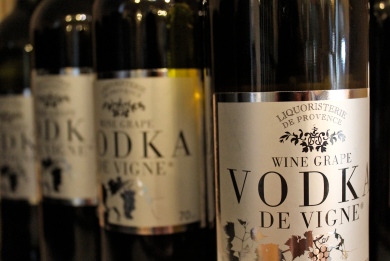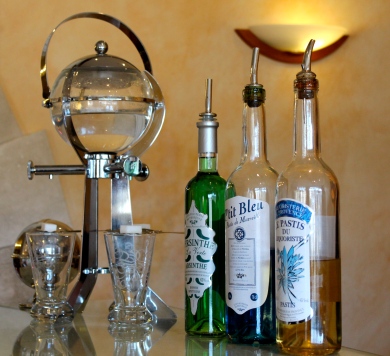Licorice, liquor and the Liquoristerie de Provence
Jan 24, 2013 in culinary journalism, worldly cuisine, absinthe, culinary journalism, liquoristerie de provence, pastis. Read the original on: Brianna R. Wilson
Just outside Aix-en-Provence, in the town of Venelles, lies a quaint, seemingly innocent building. Inside lies the mysteries of le fée verte: the green fairy. Otherwise known as the mysteries of absinthe.
The distilled beverage was known to have a high alcohol content, hallucinogenic qualities (linked to the now-banned ingredient wormwood) and inspirational to many musicians and painters. Its ban in 1914 was overcome with a revival in the 1990s.
In 1999, the Liquoristerie de Provence introduced Versinthe, the first legal absinthe allowed in France after an 84-year ban. To preserve the iconic green fairy, they retained the product’s idyllic green color. Currently, three other absinthes are available at this location: La Verte, La Blanche and Lamesinthe.
The liquoristerie somehow combines flavor in their vodka de vigne. Potato vodka seems simple, compared to this complex recipe. The liquoristerie’s formula is the only commercial product that uses every part of the grape vine: leaves, branches and grapes – giving it a subtle and delicate flavor. Smoother and less abrasive than traditional vodka, we didn’t even have to cringe during the taste test. The liquoristerie suggests serving it with caviar.
Apértifs, or alcoholic beverages served before a meal, are especially common in Provence, France. As the sun sinks, outdoor tables fill with neighbors, co-workers and friends seeking conversation, companionship and cups of apértif.
The liquoristerie makes three types of apértif. Figoun is produce similarly to Vermouth, and has flavors of fig and vanilla. Delice d’orange can be compared to a light and fruity sangria. Lastly, Délice de Peche, a peach flavored liquor.
Pastis, a common Provinçal drink is a type of apértif known as part of the apéro course. The concept is hard to grasp out of context, but one might compare it to a cocktail hour of sorts; drinks served in the afternoon after work. With traditional flavors of licorice and fennel, it seems to have a love-or-hate relationship with most Aixoise. Star anise has since replaced fennel, and other herbs are sometimes added to enhance the flavor. The liquoristerie produces three types of pastis: Le P’tit Bleu, Aqualanca and the classic Le Pastis du Liquoriste.Â
Le P’tit Bleu is organically blue: the liquoristerie waits until oranges are nearly bad, when small blue mushrooms begin to grow. Once cultivated in a sterile environment, the pressed mushrooms color the pastis bright blue. Aqualanca does not have licorice, rather highly concentrated herbs that give it a distinct flavor. The classic recipe is dressed up with flavors of sage, peppermint and verbena.
Pastis is often diluted with water, and sometimes sugar. Certain places, such as the tasting section of the liquoriste, have special contraptions to complete this task.
Digestifs are commonly served after dinner, to help “digest food.†Six flavors are produced in Venelles, including lavender-flavored liquor, as the region of Provence is known for their lavender fields.
Contact the liquoristerie directly for tours and tasting.
www.liquoristerie-provence.fr/
Read the original on: Brianna R. Wilson
Brianna R. Wilson, Brianna Rose Wilson
I am an aspiring writer, specializing in culinary journalism.







